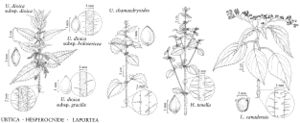Urtica dioica subsp. holosericea
Aliso 6: 68. 1967.
Illustrated
Basionym: Urtica holosericea Nuttall Proc. Acad. Nat. Sci. Philadelphia 4: 25. 1848
Synonyms: Urtica breweri S. Watson Urtica dioica var. holosericea (Nuttall) C. L. Hitchcock Urtica dioica var. occidentalis S. Watson Urtica gracilis var. greenei (Jepson) Jepson Urtica gracilis subsp. holosericea (Nuttall) W. A. Weber Urtica gracilis var. holosericea (Nuttall) Jepson
Treatment appears in FNA Volume 3.
Revision as of 07:42, 30 July 2020 by imported>Volume Importer
Stems softly pubescent, also with stinging hairs. Leaf-blades abaxially sparsely to densely tomentose to moderately strigose, soft to touch, with stinging hairs, adaxially without or rarely with a few stinging hairs. Flowers unisexual, staminate and pistillate mostly on same plants. 2n = 26.
Phenology: Flowering late spring–summer.
Habitat: Alluvial woods, margins of deciduous or mixed woodlands, fencerows, waste places
Elevation: 0-3100 m
Distribution

Ariz., Calif., Colo., Idaho, Mont., Nev., N.Mex., Oreg., Utah, Wash., Wyo., Mexico
Discussion
Urtica dioica subsp. holosericea is highly variable in leaf shape and degree of pubescence. The least pubescent plants appear to grade into U. dioica subsp. gracilis, and it is sometimes difficult to separate the two.
The name U. serra Blume has been misapplied to this taxon.
Selected References
None.
Lower Taxa
None.
... more about "Urtica dioica subsp. holosericea"
sessile +
dehiscing +
basifixed +
narrowly triangular;lanceolate +
arranged +
rounded +
unisexual +
few +
hooked +
stinging +
Present +
pedunculate +
paniculate +
axillary +
elongate +
1.1mm;1.3mm +
dotted +
equal +
2cm;13cm +
simple +
opposite +
serrate +
persistent +
hypogynous +
accrescent +
absent +
cuplike +
Aliso +
1967 +
longitudinal +
Illustrated +
absent +
pubescent +
sessile +
absent +
absent +
Urtica dioica subsp. holosericea +
Urtica dioica +
subspecies +
distinct +
smaller +
equal +
rhizomatous +
perennial +
pubescent +
small +
